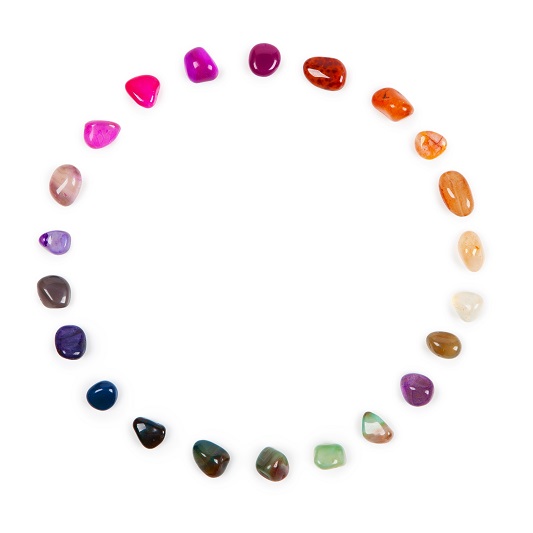Amazonite Gemstone of the Week

Jade, Gemstone of the Week
2nd February 2018
Corundum Gemstone of the Week
16th February 2018Often referred to as the ‘Amazon Stone’, Amazonite is a green variety of microcline feldspar. Though the stone is typically green in appearance, specimens can vary in colour from light green to light blue-green. Due to its soft colouring, Amazonite can sometimes be confused with Jadeite and Nephrite. The close resemblance has led to the stone being referred to as ‘Pikes Peak Jade’ or ‘Colorado Jade’ in some areas of the world. Amazonite was believed to have been named after the Amazon River in South America after the first specimen of the mineral was discovered there many years ago; however, modern mineralogists insist that Amazonite has never been found in the Amazon River. With this information in mind, it is now assumed that the stones found were actually Nephrite or Jadeite, mistakenly labelled as Amazonite due to their similar appearance. In this article, we explore Amazonite in more detail.
How to Identify Amazonite
There are a number of ways for trained professionals to identify Amazonite. For the untrained eye, though, the stone can often be confused with other similar gemstones. The most effective way to distinguish between similar minerals is to test for refractive index and density. A popular method is Polariscope testing, which can distinguish isotropic stones from anisotropic. There are only a few gemstones that are closely related to microcline feldspar, so confusion is normally kept to a minimum. Similar gemstones include Jadeite, Nephrite, Chrysoprase, Chalcedony, Turquoise, Serpentine, and Aventurine. However, Jadeite and Nephrite usually lack the white streaks present in Amazonite, so identification is fairly simple. Aventurine is a litter harder to distinguish, though many specimens boast a glitter effect that is not present in Amazonite.
Different Colours and Types of Amazonite
As mentioned previously, the colour of Amazonite can vary from light green to light blue-green. Occasionally, specimens can exhibit a yellowish tone. The blue-green colouring of Amazonite is thought to be a result of the iron impurities present in the stone. It’s fairly normal for Amazonite stones to show a variety of different colours in a single specimen. The colouring of the stone often appears irregular and mottled, with many stones exhibiting fine white streaks. While all specimens of Amazonite are popular, stones with saturated and evenly distributed colours usually hold the highest value. For the stone to look its best, it’s recommended to be viewed under warm daylight; for instance, directly after sunrise or shortly before sunset.
Amazonite gemstones are rarely transparent. Most specimens are completely opaque, though some can appear slightly translucent. When polished, the stone exhibits a desirable waxy shine and a strong lustre. While the gemstone is relatively rare, most specimens are seen as being fairly affordable. Unlike many gemstones, Amazonite is rarely treated to enhance its appearance; because of this, buyers can enjoy peace of mind that the beauty of their gemstone is completely natural. Amazonite can be found on the gemstone market in a variety of different shapes and cuts. Typically, the stones are cut en cabochon, though occasionally the gems are facetted. When it comes to Amazonite jewellery, one of the most popular varieties are tumbled stones – especially for using in beaded bracelets. A variety of Amazonite gemstone carvings have been found around the world, most notably in Egypt. Many of these can now be seen in museums, or be purchased on the gemstone market for the right price.
Where is Amazonite Found?
Today, Amazonite is only found in a few locations around the world. For many years, Russia was thought to be the only source of the lustrous green gem, though recent discoveries have found that the stone also occurs in the USA, Madagascar, Brazil, and Australia.
Healing Properties of Amazonite
Boasting an array of sought-after benefits, Amazonite is used within crystal healing to treat both physical and emotional ailments. Most commonly, the stone is known for relieving stress and anxiety and healing emotional trauma. The gem can also be used to balance and cleanse the chakras.
In terms of physical health, Amazonite is renowned for maintaining a healthy body. The gemstone contributes to cell regeneration and healing after periods of illness, and can even relieve muscle spasms associated with chronic health issues. It can also benefit those suffering from disorders of the nervous system and those experiencing issues with the thyroid gland and throat.
When used as an elixir, Amazonite is thought to treat calcium deficiency and prevent tooth decay and various forms of bone disease. An Amazonite elixir can also be used to replenish damaged hair and nails, and even prevent hair loss from occurring. A polished piece of Amazonite can be rubbed against the skin to aid or prevent infection, heal blisters, and even clear up acne.
Emotionally, Amazonite is believed to calm the mind and relieve symptoms associated with trauma. Additionally, the gemstone can help to alleviate anxiety, fear, and anger. Those suffering from irritability can benefit from owning a piece of Amazonite; simply wearing the stone around the neck is thought to regulate aggressive emotions and encourage emotional balance within the body and mind.
In Summary
Lustrous Amazonite is popular all around the world. Today, the most notable deposits of the stone are still found in Russia, though gems have been discovered in the USA, Australia, Madagascar, and Brazil, too. Loved for its saturated colours and waxy shine, good-quality Amazonite is often used in designer jewellery. Whether you’re hoping to use the stone for its benefits within crystal healing or you’re looking for a beautiful new addition to your jewellery collection, purchase a good-quality piece of Amazonite to reap the benefits.




